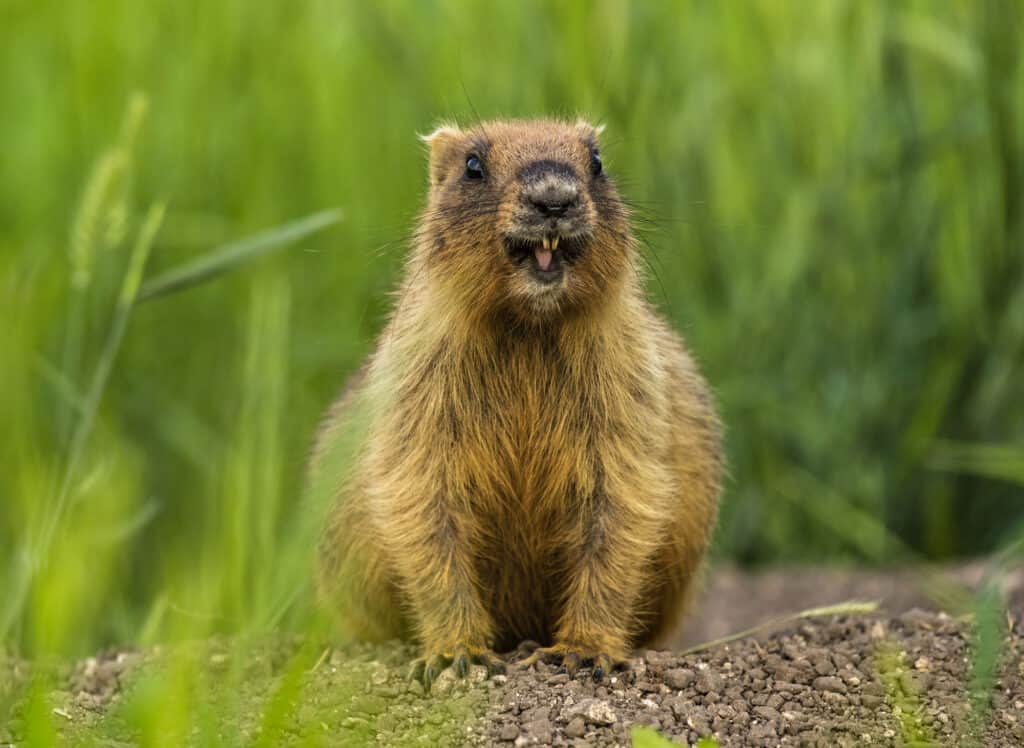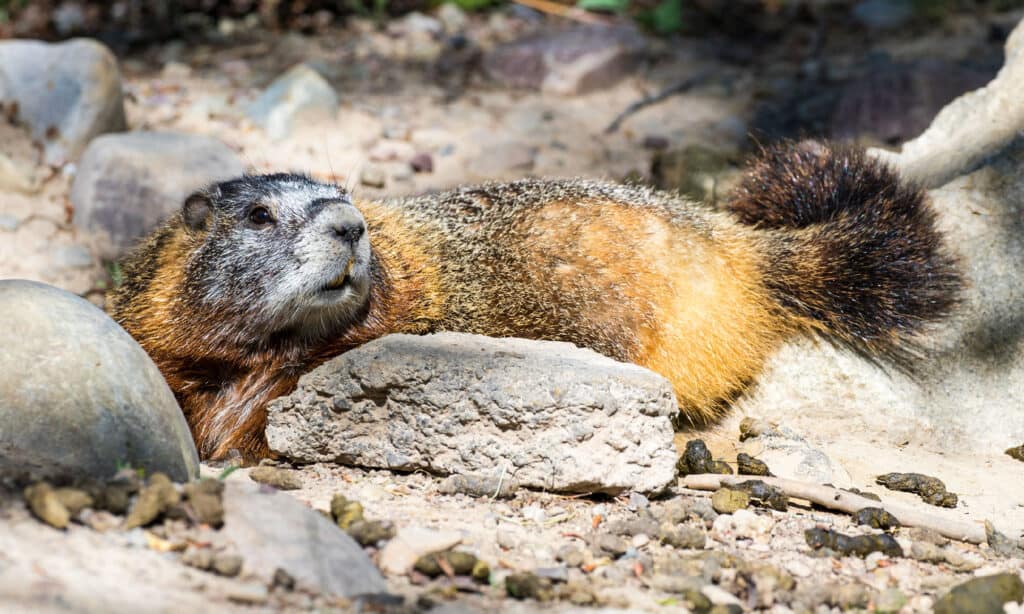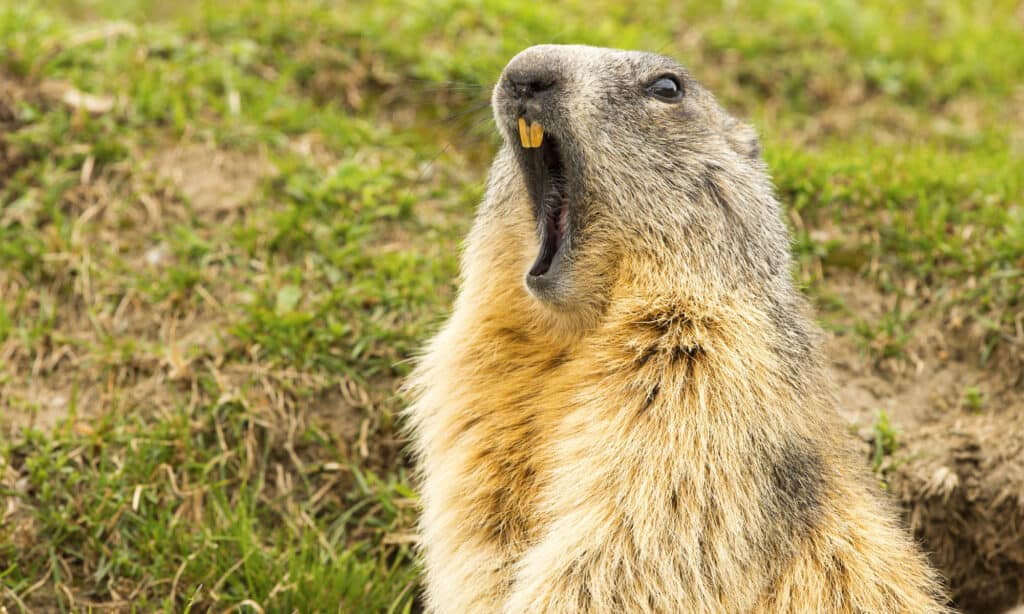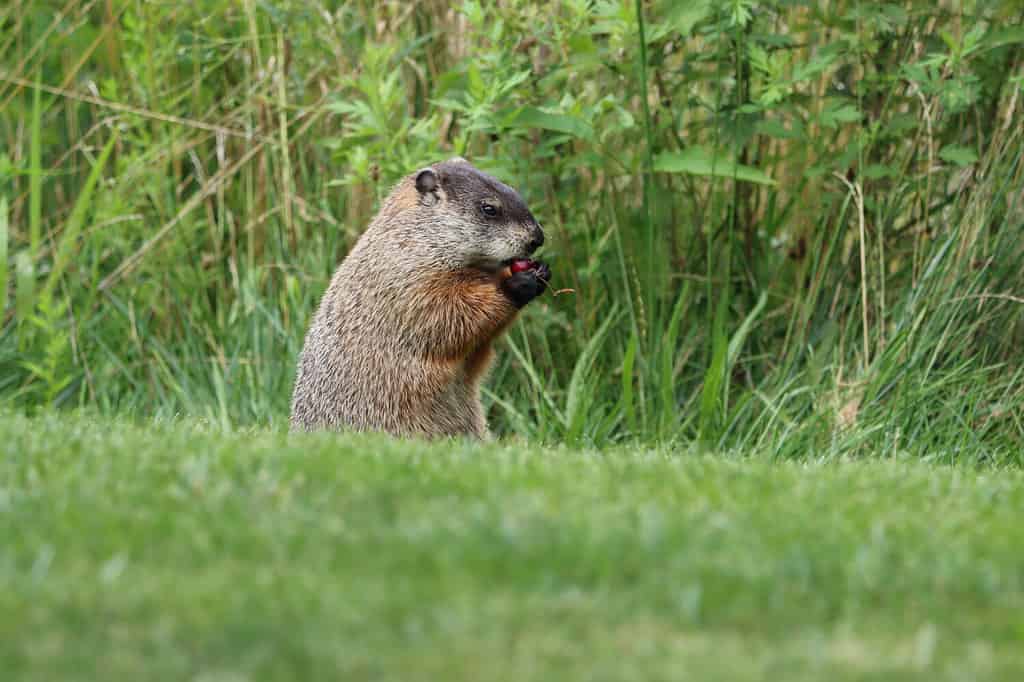Groundhogs, also known as woodchucks, are very clean animals, even if their effect on your garden suggests otherwise. They are the biggest in the family of rodents. They are so clean that it is possible to have one of such animals in the neighborhood for months and not find their scat anywhere. How is this possible?
The answers lie in this post which aims to show you everything you’ve ever wanted to know about the groundhog poop.
What Do Groundhogs Do To Their Poop?

Groundhogs dispose of their metabolic waste in underground tunnels.
©toha90/Shutterstock.com
Groundhogs (woodchuck) leave their trail of destruction and disruption in any garden they invade. However, there is one thing they hardly leave behind and that is their poop. Like every other rodent, like rats, hamsters, and guinea pigs, they excrete metabolic waste. But why can’t you find their scat around?
This point is perhaps the most interesting fact you would want to know about these giant rodents. Groundhogs dispose of their metabolic waste in underground tunnels. That is a sophisticated way of disposing of waste for an animal.
Many people formerly believed that groundhogs buried their droppings after excreting. However, studies showed that these mighty rodents have particular locations underground where they go to excrete.
The amazing part is that the groundhogs dig these tunnels themselves. Also, it is not just an underground ditch for poop. It is usually a long tunnel with many compartments to escape dangers. This attribute shows that groundhogs, for all their troubles and destructive characters, are clean animals.
So, if you sense the presence of groundhogs in your garden or on your larger farms, the absence of poop can indicate that they are the culprit. However, there are additional ways to prove your suspicion. That is by identifying groundhog poop if you should see them.
What Does Groundhog Poop Look Like?

In rare situations, one would find woodchucks’ digestive waste in the open.
©iStock.com/moose henderson
Groundhogs are rodents, and one of the many things they have in common is the shape and size of their scat. Like many other rodents, these animals ‘ digestive waste is dry, small, and oval. A significant variation exists in color. It is dark brown, while other rodents like squirrels can have dark poop.
Interestingly, the other common species of rodents found majorly in a domestic environment is a rat. Rat excreta is similar to that of groundhogs, but you will never find rat droppings in an underground tunnel. Also, rats walk as they poop, so it is common to find the poop scattered all around the garden, unlike groundhogs.
In rare situations, one would find woodchucks’ digestive waste in the open. This limits exposure to it. However, does exposure to these wastes pose a health risk? Let’s find out.
Is Groundhog Poop Harmful?
Groundhogs are wild animals that come in contact with many insects and infections. Many tend to ask the question: are groundhogs dangerous? However, another question that is worth asking is whether their waste is harmful. Their poop also poses a few health risks to humans. However, this risk is reduced because groundhogs bury their poop.
One noteworthy point about groundhog poop is that it is only in cases of infection that one can find these poops easily. What does that mean? Rabies is an infection that affects groundhogs and their metabolic behavior. If this clean animal should get infected with rabies, they become erratic. They tend to dispose of their metabolic waste anywhere and everywhere.
If you find groundhog poop frequently on your farm, this animal may suffer from rabies. However, this particular situation presents no cause for concern. Rabies cannot travel through contact with excrement.
However, this is not the real danger. The actual threat is a disease known as tularemia. The name might sound amusing, but the effect of this disease is everything but funny. It is a transmittable disease that affects the skin, lungs, eyes, and other significant parts of the body. This disease can lead to coughing, difficulty in breathing, and chest discomfort. In severe cases, it leads to skin ulcers.
With groundhog poop, there is good news and bad news. The bad news is that this disease can be fatal if not readily treated. While the good news is that tularemia is the only disease that humans can get from contact with groundhogs droppings. What’s more? It is infectious but not contagious. This statement means that while it can travel from groundhog waste to humans, it cannot travel from one human to another.
One would want to avoid these animals’ metabolic waste at all costs. Still, they are essential if you know how to handle them.
Uses of Groundhog Poop

Groundhogs like to smell poop.
©Andrea Izzotti/Shutterstock.com
Most animal poops are waste products that serve no purpose. Few animals excrete metabolic waste with economic value, such as fertilizer. Groundhogs fall in an entirely different category.
Amazingly, woodchucks poop can attract and catch a groundhog. Yes, the best way to trap these giant rodents is by using scats of the same species. The underground lifestyle of woodchuck makes it a difficult animal to find or catch. So it is best to lure them out and catch them in the open. This situation makes acquiring their scat even more precious. Admittedly, that bit is also difficult.
Groundhogs are unique creatures with quirky habits, and their underground tunnels prove that statement. However, the uniqueness does not end there. Like some other curious animals, groundhogs like to smell poop. Animals like dogs like to smell the poop of other animals, and this is not very uncommon.
However, groundhogs like to smell the metabolic wastes of their species. It is hard to understand the reason for this behavior. But it is all you need to catch a groundhog and rid your garden of this troublesome destroyer.
Once you acquire the poop, drop it in the garden and set up a trap to catch the animal. Interestingly, you might need to catch the first woodchuck to acquire the excreta if you can’t find it on the farm.
So basically, you need a groundhog to acquire groundhog poop. You also need groundhog poop to catch a groundhog. That is not confusing at all.
Bonus: Is it a Good Idea to Feed Groundhogs?

Groundhogs are cute and fun to watch.
©Lisa Basile Ellwood/Shutterstock.com
Woodchucks are often considered to be a nuisance but they are also very cute and have charmed many people into feeding them just to watch them eat happily. Is this a good idea? Probably not. Here are a few reasons not to feed a groundhog:
- Overfeeding. Groundhogs will eat whatever they can get and they aren’t going to resist your offerings. This could lead to obesity and other health issues.
- Disease transmission. Woodchucks can carry parasites and diseases that could be transmitted to you or your pets.
- Dependency on humans. It’s not a good idea for a wild animal to become dependent on humans and fail to pass on foraging techniques to offspring.
If you want to throw out the occasional treat – make sure that it is a fresh fruit or vegetable. Processed food and sugary treats can make groundhogs sick.
The photo featured at the top of this post is © iStock.com/mirecca
Thank you for reading! Have some feedback for us? Contact the AZ Animals editorial team.






